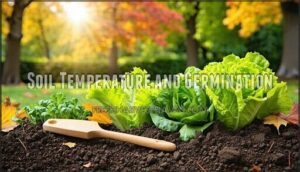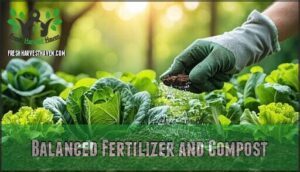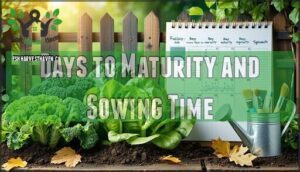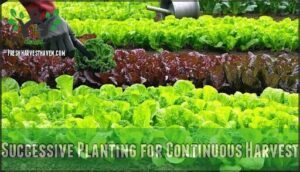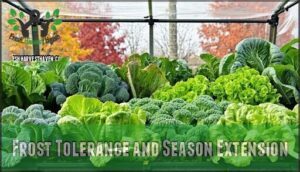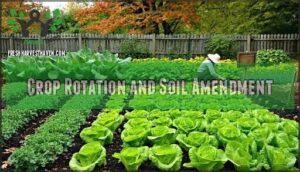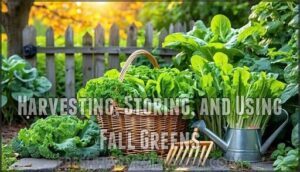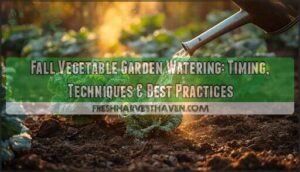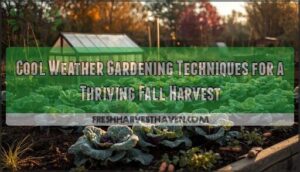This site is supported by our readers. We may earn a commission, at no cost to you, if you purchase through links.
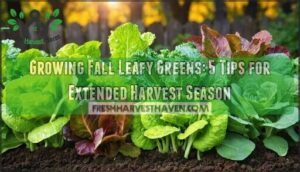
Work compost into your beds two weeks before sowing, then watch as spinach and mizuna keep producing fresh salads well into winter. The secret lies in timing your plantings just right and understanding which protection methods turn good harvests into outstanding ones.
Table Of Contents
- Key Takeaways
- Benefits of Growing Fall Leafy Greens
- Best Leafy Greens for Fall Gardens
- Preparing and Planting Your Fall Greens
- Protecting and Maintaining Fall Leafy Greens
- Harvesting, Storing, and Using Fall Greens
- Frequently Asked Questions (FAQs)
- Can you grow greens in the fall?
- Is October too late to plant greens?
- What month do you start your fall garden?
- What are the easiest leafy greens to grow?
- Can fall greens survive unexpected early snowfall?
- Which fall greens attract the fewest garden pests?
- How deep should fall greens be planted?
- Do fall greens need different watering schedules?
- Can you save seeds from fall greens?
- What pests commonly attack fall leafy greens?
- Conclusion
Key Takeaways
- You’ll get sweeter, more flavorful greens by planting when soil temperatures drop below 70°F – cool weather actually improves taste while reducing pest pressure that plagues summer gardens.
- You can extend your harvest well into winter by using row covers and mulch for frost protection, plus timing successive plantings every 2 weeks for continuous fresh salads.
- You’ll maximize your garden’s productivity with cut-and-come-again harvesting – cut outer leaves while leaving the growing center intact so plants keep producing for months.
- You should choose hardy varieties like kale, arugula, and spinach that thrive in cool conditions and can handle light frost, giving you fresh greens when store prices are highest.
Benefits of Growing Fall Leafy Greens
You’ll discover that fall’s cool temperatures actually boost your leafy greens’ flavor while reducing the pest pressure that makes summer gardening feel like a battle.
These hardy crops keep producing fresh salads well into winter, giving you months of homegrown nutrition when grocery store greens cost a fortune.
Cooler Temperatures and Increased Yield
Fall’s cooler temperatures create perfect conditions for growing leafy greens in your fall garden. Cool season crops thrive when daytime temps drop below 75°F, boosting yield optimization naturally.
Here’s why temperature control matters for your fall harvest:
- Stress reduction – Plants focus energy on leaf production instead of surviving heat
- Enhanced flavor – Cold hardiness develops sweeter, more tender greens
- Faster growth – Ideal conditions mean quicker seasonal harvesting cycles
Fall garden planning around temperature gives you the best growing leafy greens experience.
Extended Harvest Season
Your fall harvest season stretches well beyond summer’s end with proper season extension techniques. Frost protection using row covers lets you keep harvesting fall greens through winter.
Cut-and-come-again harvesting methods mean you’ll gather fresh leaves for months instead of weeks.
With smart storage and preservation, your greens stay crisp long after harvest.
Continuous Supply With Successive Planting
Think of successive sowing as your garden’s insurance policy against empty salad bowls. Plant small batches of leafy greens every two weeks throughout fall, and you’ll have fresh harvests rolling in like clockwork.
This staggered fall planting approach means when your first kale crop starts winding down, the next batch is already sizing up for harvest scheduling accuracy.
Year-Round Salad Production
Cultivating year-round salad production transforms your fall garden into a continuous harvest powerhouse. Strategic salad crop rotation ensures fresh leafy greens through winter months. Here’s your year-round game plan:
- Plant cold hardiness champions like kale varieties
- Utilize greenhouse production for tender greens
- Experiment with hydroponic systems indoors
- Master vertical gardening techniques
- Time harvesting greens for seasonal flavor profiles
You’ll enjoy crisp salads even when snow flies outside.
Best Leafy Greens for Fall Gardens
You’ll want to choose greens that actually thrive when temperatures drop, not just survive them. Smart picks like kale, arugula, and spinach get sweeter after frost, while hardy varieties like mizuna and mâche will keep producing fresh salads well into winter.
Fall’s cooler temperatures turn leafy greens into flavor powerhouses while hardy varieties keep your salads fresh through winter
Arugula and Kale Varieties
You’ll love these powerhouse greens for your fall garden planning. Arugula grows incredibly fast, delivering peppery leaves packed with arugula nutrition in just 21 days.
For kale varieties, try curly types for hearty kale recipes or tender Lacinato for salads. Both leafy greens thrive in cool weather, making fall harvesting a breeze.
These champions of fall vegetable gardening practically grow themselves once established.
Swiss Chard and Mustard Greens
Swiss Chard and Mustard Greens pack serious punch in your fall vegetable garden. These leafy greens thrive when temperatures drop, delivering exceptional chard nutrition and bold mustard recipes.
You’ll discover vibrant chard varieties—from rainbow stems to deep emerald leaves—perfect for green pesto. Mustard greens add spicy kick while providing essential leafy benefits that’ll keep your family healthy all season.
Lettuce, Spinach, and Hardy Asian Greens
Your fall vegetable garden deserves powerhouse Lettuce Varieties like buttercrunch and romaine. Spinach Nutrition speaks for itself—packed with iron and vitamins.
Asian Green Cultivation brings tatsoi and mizuna into the mix. When Leafy Green Pests show up, these hardy Leafy Green Vegetables bounce back faster.
Smart Greens Seed Selection keeps your fall garden producing.
Unusual Varieties and Tasty Micro-Greens
Beyond standard greens, you’ll discover exciting Unusual Varieties like Exotic Kale and Heirloom Greens. Lacinato Kale and Curly Purple Kale offer stunning colors, while Specialty Lettuce adds visual appeal.
Tasty MicroGreens like amaranth and beet deliver concentrated Micro Green Benefits—up to 40 times more nutrients than mature leaves. Baby Broccoli microgreens pack serious flavor punch in tiny packages.
Incorporating cold tolerant greens can extend the harvest season and provide a consistent supply of fresh produce.
Preparing and Planting Your Fall Greens
Getting your fall greens off to a strong start means timing your planting just right and giving your soil the boost it needs.
Work some compost into your beds about two weeks before sowing, then plant your seeds when soil temperatures drop below 70°F for the best germination rates.
Soil Temperature and Germination
Success starts with getting your planting site’s temperature just right. Cool weather leafy greens germinate best when soil temperature sits around 70°F, making timing vital for your fall garden’s growing cycle.
- Check soil moisture before sowing – it affects germination rates
- Plant at proper seed depth (usually ¼ inch)
- Monitor soil pH between 6.0-7.0 for ideal leafy green planting
- Use temperature control methods like row covers when needed
Balanced Fertilizer and Compost
Your leafy greens need proper soil nutrition to thrive through fall’s changing conditions. Mix balanced fertilizer with organic matter before planting—think 10-10-10 ratios work well for most varieties.
Compost tea weekly boosts microbial balance while addressing fertilizer needs naturally.
Rich compost creates the foundation for healthy growing and care of leafy greens, preventing common leafy green problems before harvesting leafy greens begins.
Days to Maturity and Sowing Time
Timing your sowing schedules matters more than you’d think. Days to maturity range from 40-80 days for most leafy greens, so count backward from your first frost date.
Start seeds indoors in July for cooler climates to plant in August or September. When to plant depends on your zone, but begin planting in late summer, up until about 6 weeks before your hard frost date. Quick seed germination happens in cool weather.
Understanding the essential year round growth strategies is vital for a successful harvest.
Successive Planting for Continuous Harvest
With garden planning, you’ll want to stagger your seed starting every 10-14 days for continuous harvest scheduling. This successive planting approach ensures fresh greens hit your table when others finish.
Consider each variety’s days to maturity and cold hardiness when timing fall planting. Crop rotation between beds maximizes soil preparation, while cut-and-come-again harvesting extends each planting’s productivity.
Protecting and Maintaining Fall Leafy Greens
Once your fall greens are established, you’ll need to shield them from harsh weather while keeping the soil consistently moist and nutrient-rich. Think of it like tucking your plants under a cozy blanket—row covers and mulch become your best friends when temperatures start to drop unexpectedly.
Row Covers, Cloth Covers, and Mulch
Why let your Fall Planting become frost’s victim when Crop Covers offer simple Frost Protection? Row covers and Garden Mulching create a cozy microclimate for your leafy greens, extending your fall garden season effortlessly.
- Crop Covers trap soil heat for Cold Hardiness
- Mulch provides Soil Insulation year-round
- Row covers offer Weed Suppression naturally
- Fall Gardening extends with simple protection
Frost Tolerance and Season Extension
Understanding your leafy greens’ Cold Hardiness is like knowing which friends show up when the weather gets rough. Kale and collards laugh at frost down to 20°F, while lettuce needs frost protection around 28°F.
Smart Fall Gardening means creating your own microclimate management with cold frames or season extenders, turning harsh conditions into winter harvesting opportunities.
Monitoring Soil Moisture and Nutrient Levels
Successful fall gardens depend on staying tuned to what your soil needs. Leafy greens are thirsty crops that’ll signal distress through wilting or yellowing if you’re not paying attention. Here’s your monitoring checklist:
- Soil Testing – Check pH and nutrient levels monthly during growing season
- Moisture Sensors – Use finger test or digital tools to maintain consistent dampness
- Fertilizer Application – Apply balanced nutrients every 3-4 weeks for continuous harvest season
- Compost Management – Layer organic matter to support nutrient cycling naturally
- Cold Hardiness tracking – Monitor soil temperature as it affects nutrient uptake in fall garden conditions
Crop Rotation and Soil Amendment
Rotating your fall garden prevents leafy greens from depleting specific nutrients while building Organic Matter through Nutrient Cycling. Smart rotation keeps your harvest season productive year after year.
Plan next season’s Crop Planning by following heavy feeders like kale with nitrogen-fixing legumes, then root crops. Regular Soil Testing reveals what your growing season needs, while Compost Tea applications boost Cold Hardiness.
Harvesting, Storing, and Using Fall Greens
You’ll discover that harvesting your fall greens becomes second nature once you learn the simple "cut and come again" method that keeps plants producing for weeks.
Proper timing and storage techniques will help you make the most of your garden’s bounty, turning crisp leaves into delicious meals that taste infinitely better than anything you’ll find at the store.
Cutting and Coming Again Techniques
The secret to maximizing your fall harvest lies in mastering cut-and-come-again harvesting techniques. This approach transforms your kale and other leafy greens into productive workhorses that keep delivering fresh leaves all season long.
- Cut outer leaves first – Harvest from the outside while leaving the growing center intact for continuous regrowth strategies
- Use sharp, clean shears – Proper cutting methods prevent disease and encourage faster crop renewal after leaf pruning
- Leave 2-3 inches of stem – This harvest timing ensures the plant can regenerate effectively without stress
- Fertilize after cutting – Feed your plants post-harvest to fuel the next growth cycle and avoid common leafy green problems
Timing for Optimal Flavor and Texture
Harvest timing transforms your greens from good to exceptional. Pick leafy vegetables when they’re young and tender for the sweetest flavor profiles. Cool fall weather actually improves taste – kale gets sweeter after light frosts, while arugula develops perfect peppery notes.
Check maturation rates regularly since ideal picking windows are shorter than summer crops.
Storage and Preservation Methods
Once you’ve harvested your greens at peak flavor, proper storage and preservation become your best friends for extending that garden-fresh taste. Cold storage works wonders – keep leafy greens in your fridge at 32°F with high humidity for two to three weeks.
Freezing methods work great for heartier varieties like kale and collards, while dehydration techniques preserve nutrients beautifully. Vacuum sealing locks in freshness longer than traditional storage.
Culinary Tips and School Garden Recipes
Beyond fresh Leafy Salads, your Fall Garden harvest transforms into exciting School Meals that kids actually crave. Mixing Kale with sweeter greens like Spinach creates balanced Garden Nutrition that doesn’t taste like punishment.
- Try crunchy Arugula in wraps – its peppery kick makes Fall Recipes memorable
- Blend Swiss Chard stems into smoothies for sneaky vitamins in Harvest Menus
- Create rainbow salad bars letting students choose their own colorful combinations
- Make kale chips seasoned with garlic powder – they’ll disappear faster than cookies
Frequently Asked Questions (FAQs)
Can you grow greens in the fall?
Yes, you can absolutely grow greens in fall! **Cooler temperatures actually make leafy greens sweeter and more tender.
**
Kale, arugula, spinach, and collards thrive in autumn’s crisp conditions, often outperforming their summer counterparts.
Is October too late to plant greens?
Think October’s too late? You’d be wrong – quick-growing spinach, lettuce, and kale thrive in cooler temperatures and can still mature before your first hard freeze arrives.
What month do you start your fall garden?
Start your fall garden in mid to late July for most areas. This timing gives leafy greens enough growing time before hard frost arrives in fall.
What are the easiest leafy greens to grow?
Looseleaf lettuce is the easiest to grow, maturing in just 40-50 days!
You’ll also love spinach, arugula, and kale—they’re virtually foolproof for beginners and forgive most gardening mistakes you’ll inevitably make.
Can fall greens survive unexpected early snowfall?
Most hardy greens can tough out early snowfall, but they’ll need protection. Collards can withstand winter temps down to 5°F, while kale and arugula handle light snow with row covers or mulch for backup protection.
Which fall greens attract the fewest garden pests?
Want pest-free greens that practically grow themselves? Arugula and mustard greens naturally deter many insects with their spicy compounds, making them your best bet for low-maintenance fall gardening that bugs simply can’t stomach.
How deep should fall greens be planted?
Most fall greens need shallow planting – just quarter to half-inch deep. You’ll plant lettuce, spinach, and arugula seeds barely under the soil surface.
Larger seeds like kale go slightly deeper at half-inch maximum.
Do fall greens need different watering schedules?
Since 85% of a green’s weight comes from water, you’ll need consistent moisture but shorter sessions. Cool weather means less evaporation, so water 2-3 times weekly instead of daily like summer crops.
Can you save seeds from fall greens?
Let some plants bolt and flower instead of harvesting them. Once seed pods dry on the plant, collect them carefully.
You’ll need to hang stalks upside down for drying, then collect seeds from pods that tend to shatter when ripe.
What pests commonly attack fall leafy greens?
As they say, the best defense is a good offense – you’ll battle aphids, cabbage worms, flea beetles, and thrips primarily.
Aphids multiply rapidly in cool weather, while cabbage worms create telltale holes, and thrips cause tiny spots and leaf curling.
Conclusion
Like medieval peasants storing turnips in root cellars, you’ll discover that growing fall leafy greens transforms your garden into a winter treasure trove. These hardy crops reward patience with sweeter flavors and extended harvests.
Your careful timing and protection methods pay dividends when fresh kale and spinach grace your table while neighbors browse grocery stores. You’ve mastered the art of cool-season cultivation – now enjoy the fruits of your labor through winter’s embrace**.
- https://ucanr.edu/site/uc-master-gardener-program-alameda-county/cool-weather-vegetable-gardening-late-summer-or
- https://kidsgardening.org/resources/growing-guide-fall-greens/
- https://piedmontmastergardeners.org/article/growing-fresh-fall-greens/
- https://extension.okstate.edu/fact-sheets/cool-season-greens-production-spinach-collard-kale-mustard-turnip-leaf-lettuce.html
- https://www.acadlore.com/article/OF/2022_8_1/of2022.08010003


